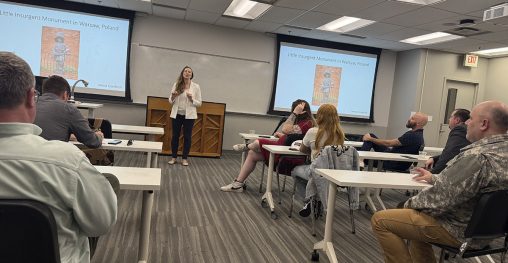
Wright State’s Veteran and Military Center brought together student veterans, service members and military families for a discussion series that used images of war to explore personal military experiences.
The adage “a picture is worth a thousand words” aptly describes Dialogues on The Experience of War: Images Past and Present, a monthly series designed to facilitate conversations about war with veterans, military-connected students and others in the Wright State University community.
Dialogues on the Experience of War was a long-standing and well-respected national program funded by the National Endowment for the Humanities. Funding for discussion groups of student veterans, veterans and military family members at Sinclair College and Wright State University was initiated by Kay Koeninger, a professor of art history at Sinclair. The focus was visual arts that focused on war, with an emphasis on examples from the Civil War and the Vietnam War.
The Veteran and Military Center (VMC) sponsored Wright State’s series to spark thoughtful reflection on participants’ military experiences through the use of visual depictions of war.
“How do you normalize the experience of going to war?” said Seth Gordon, Ph.D., director of the Veteran and Military Center. “That has been the challenge for me as the director of the VMC for over a decade. The answer that myself and others have come to is through storytelling. The unfortunate truth about war is that a veteran from 50 years ago or five share similar experiences and connections. The gear and food may be different, but the emotions and the connections of those who have served can transcend time.”
Participants included students, staff and alumni who are veterans of the U.S. Army, Air Force and the Marine Corps, as well as civilian graduates and community members. During each session, attendees shared the stories behind the images and explained why those images were so impactful.
For instance, a graphic photo from November 1943 conveyed what took place in battle during World War II, one presenter said, not the sanitized versions meant for public consumption.
“The image is not congruent with what I was taught about World War II,” a Marine Corps veteran said. “Censorship warps reality.”
Mariah Gist, a graduate student in the Wright State Student Affairs in Higher Education and Air Force veteran, helped coordinate the Dialogues of War sessions as a student intern.
“Presenting was deeply emotional for me,” Gist said. “I come from a family with generations of military veterans, many of whom made it clear that they didn’t want to discuss or highlight their military careers. They often said the military wasn’t a place for Black people during their time in service. Because of that, I felt it was my responsibility to honor and highlight the contributions of my ancestors and elders. They paved the way for others like me and were an important part of history.”
The series allowed Gist to see firsthand how people develop their perspectives on historical events.
“I really enjoyed analyzing art and being open to the different interpretations it sparked,” said Gist, who is also a civilian employee at Wright-Patterson Air Force Base. “Some of my peers had field experience, which added even more depth to our conversations and helped us see things from different angles.”
Gordon collaborated with Benjamin Montague, professor of photography at Wright State, who facilitated discussions on how to approach a piece of art as well as curating the images reviewed in three of the five sessions.
Montague emphasized how engaged the participants were, often offering deeply personal insights and observations sparked by the art. He said participants often noticed subtle details in the artwork that only someone with military experience would catch. While discussing a photograph of an American soldier standing atop a destroyed Iraqi tank, veterans identified sensory elements — like the smell of burning oil — and offered deeper context.
“They pointed out that the soldier’s gun wasn’t loaded and that he had likely found the tank and posed, turning the scene into a kind of trophy shot,” Montague said. “That kind of insight was invaluable for non-veterans in the group.”
For her presentation, Gist chose a political cartoon by John Tenniel titled “One Good Turn Deserves Another,” which depicts President Lincoln recruiting an enslaved person named Sambo to fight for the Union. While the piece is satirical and controversial, Gist felt it was important in understanding the role of African Americans during the Civil War.
“These contributions showcased what we were capable of and our patriotism,” she said. “Fast forward, we began to see desegregated units, Black commanding officers and other important changes. I was grateful to be able to share this information with my peers and engage in open dialogue about our perspectives on the war.”
Gist said she hopes the series of dialogues will continue.
“It has been an invaluable experience and I’m confident it will provide future participants with the same meaningful opportunities and insights,” she said.

 Wright State Police Department delivers major donation to Raider Food Pantry
Wright State Police Department delivers major donation to Raider Food Pantry  Wright State engineering and computer science students earn prestigious federal SMART Scholarships
Wright State engineering and computer science students earn prestigious federal SMART Scholarships  Wright State Police Chief Kurt Holden selected for prestigious FBI National Academy program
Wright State Police Chief Kurt Holden selected for prestigious FBI National Academy program  Wright State’s Raj Soin College of Business ranked among the best for entrepreneurs by Princeton Review
Wright State’s Raj Soin College of Business ranked among the best for entrepreneurs by Princeton Review  Wright State’s annual Raidersgiving draws hundreds
Wright State’s annual Raidersgiving draws hundreds 